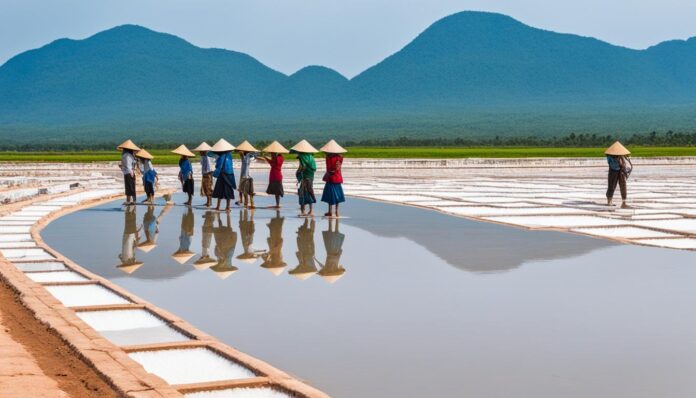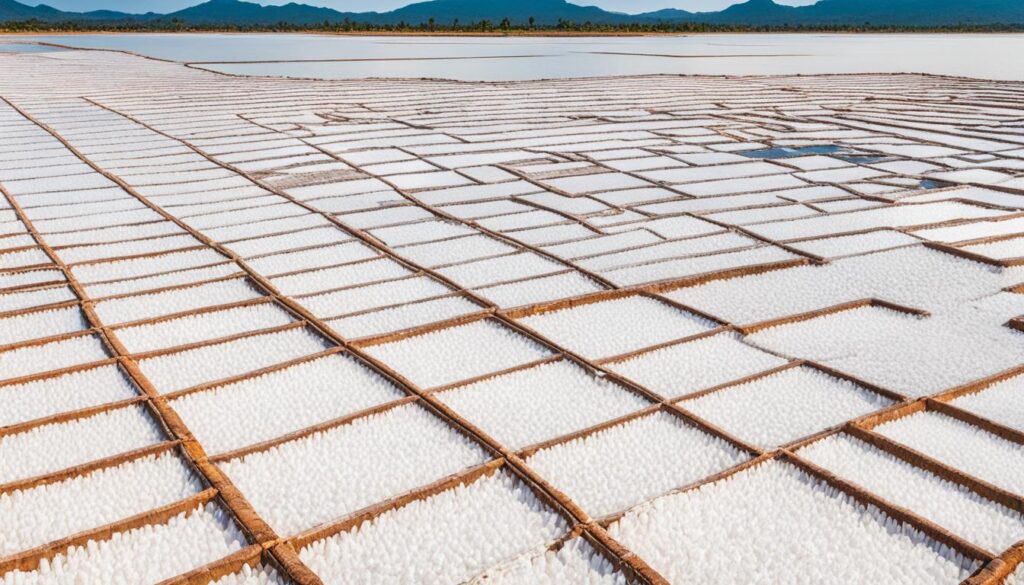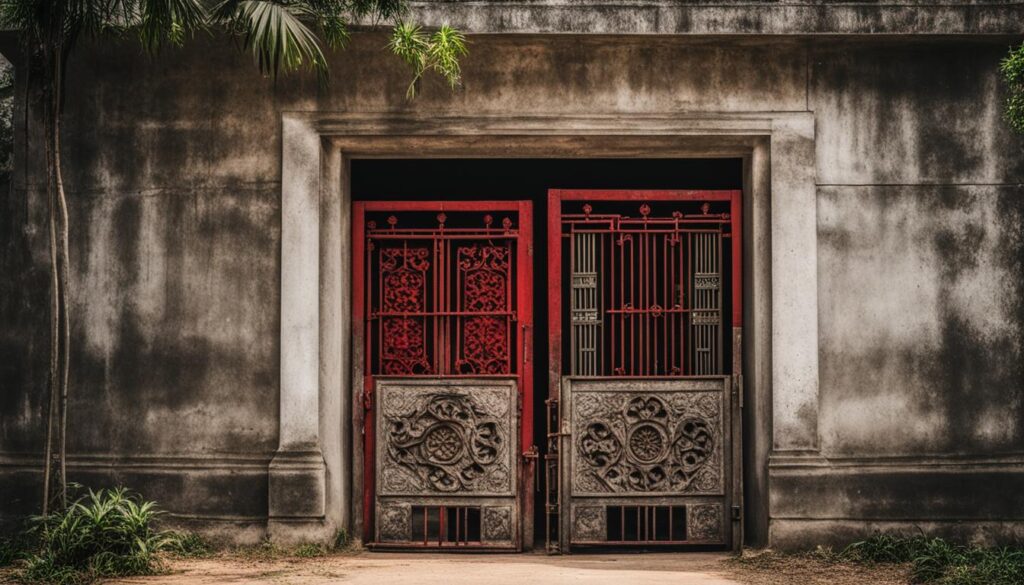If you’re looking for a unique cultural experience, learning about the Khmer Rouge history and visiting the Kampot Salt Fields in Cambodia should be at the top of your list. These two destinations offer a fascinating glimpse into Cambodia’s past and present, combining the solemnity of the Khmer Rouge regime with the serene beauty of the salt fields.
In this article, we’ll explore the historical significance of both these sites and provide tips on how to make the most out of your visit. Whether you’re interested in history or nature, there’s something for everyone here. So, prepare for an unforgettable journey into Cambodia’s past and present!
Understanding the Khmer Rouge Regime
In the 1970s, the Khmer Rouge regime, led by Pol Pot, rose to power in Cambodia, plunging the country into a time of immense suffering. The Khmer Rouge promoted a radical communist ideology and sought to create a self-sufficient society in which cities and individuality were abolished. Instead, these ideas led to a society torn apart by violence and fear.
During their rule, the Khmer Rouge committed atrocities on a massive scale, including the torture and execution of perceived enemies of the state. The Khmer Rouge regime was responsible for the deaths of an estimated 1.7 million Cambodians.
The Khmer Rouge genocide targeted anyone deemed to be an intellectual, religious leader, or member of the previous government. Families were forced to live and work together in labor camps, enduring brutal conditions and malnutrition. Those who refused to comply were killed or subjected to torture.
Despite this dark chapter in Cambodia’s history, there are survivors who have bravely shared their stories. Hearing from these survivors is an essential part of understanding the Khmer Rouge regime’s impact on the Cambodian people.
“They forced us to kneel and blindfolded us. They told us that they were taking us to another work site. Then they hit us with a hoe. I was struck on the back of my head; the blade went right through my flesh. I fell down and lost consciousness.”
Exploring the Kampot Salt Fields
The Kampot Salt Fields are a must-visit destination in Cambodia, world-renowned for their calm and tranquil environment. It is no wonder that thousands of tourists flock to the region every year to explore the historical and cultural significance of the salt fields.
The salt production process in Kampot has remained unchanged for generations and continues to be a vital part of the local economy. The fields rely on a unique ecosystem, with seawater from the Gulf of Thailand flowing into the fields through a channel system. As the water evaporates, it leaves behind salt crystals that can subsequently be extracted from the fields.
Moreover, salt holds great cultural significance in Cambodia, with different varieties of salt used in traditional dishes and religious ceremonies. The Kampot salt, in particular, is known for its unique taste and texture, making it a delicacy in Western cuisine.
“The Kampot Salt Fields are beautiful and a cultural experience. The air is salty and refreshing, and it is fantastic to see the various stages of salt production taking place. It is also an excellent opportunity to interact with the locals and learn more about their way of life.” – Traveller Review
Historical Significance of the Kampot Salt Fields
The Kampot Salt Fields have a rich history that dates back centuries. However, during the Khmer Rouge era, the fields served a different purpose. The regime forced thousands of people to work in the fields, using them as a tool for their twisted vision of a self-sustaining Cambodia.
Despite the atrocities that took place, the Kampot Salt Fields continue to play an important role in Cambodian culture and economy. Today, the fields are viewed as a symbol of resilience and hope, a testament to the endurance of the human spirit.
“The salt evokes a lot of memories — both good and bad,” says Sok Leap, a salt farmer in Kampot. “For many Cambodians, it’s a reminder of the past. But for us, it’s also a source of income and pride.”
The salt harvested from the Kampot Salt Fields is renowned for its high quality and unique flavor. It is widely used in Cambodian cuisine and is exported to countries around the world. By visiting the fields and supporting the local salt farmers, you can help preserve this important part of Cambodian heritage while also contributing to the local economy.

Visiting the Khmer Rouge Museum
To gain a deeper understanding of Cambodia’s history, you must visit the Khmer Rouge Museum. Formerly known as the Tuol Sleng Genocide Museum, this museum offers a comprehensive view of the atrocities committed during the Khmer Rouge regime. A visit here will give you a glimpse into the horrors that the Cambodian people endured during this period.
The museum is located in Phnom Penh, the capital city of Cambodia, and is a must-visit for anyone interested in Khmer Rouge history. It is housed in a former school that was used as a prison during the regime. The walls of the museum are adorned with pictures of the prisoners and guards, giving visitors a visual representation of the horrors that took place.
Inside the museum, you will find a collection of exhibits showcasing the various aspects of the regime’s history. These exhibits include photos, videos, and personal accounts of survivors. The museum also has a section dedicated to the victims of the regime, including galleries with portraits of those who were killed.
The Importance of Visiting the Museum
While the history of the Khmer Rouge regime is a dark and painful chapter in Cambodia’s past, a visit to the museum is an important part of understanding the country’s present. It is widely believed that by understanding the past, we can better avoid repeating it.
Visiting the Khmer Rouge Museum will give you a greater appreciation for the resilience and strength of the Cambodian people. You will leave with a newfound understanding of the atrocities committed during the regime and a deeper appreciation for the country’s culture and heritage.
Journeying into the Past: The Killing Fields
The Khmer Rouge era was marked by unimaginable horrors, and few places bear witness to the atrocities committed by Pol Pot’s regime like the Killing Fields. These sites, scattered throughout Cambodia, serve as a stark reminder of the country’s dark past and the brutality of the Khmer Rouge regime.
The Killing Fields were once execution grounds for prisoners held in Khmer Rouge detention centers. Victims were subjected to unimaginable torture, cruel punishment, and inhumane living conditions before being brought to the Killing Fields to be killed. The sites are strewn with mass graves and human bones, which serve as haunting reminders of the scale of the Khmer Rouge’s atrocities.
Today, the Killing Fields serve as memorials to those who lost their lives during the Khmer Rouge era. They offer a chance to reflect on the past and pay respects to those who suffered under the regime.
Visiting the Killing Fields can be an emotional and challenging experience, but it is an essential part of understanding Cambodia’s history. The sites offer a profound insight into the traumatic events that took place during the Khmer Rouge era, and they serve as a powerful reminder of the importance of promoting human rights and justice around the world.
Seeking Hope amidst Tragedy: Cambodian Genocide Survivors
The Khmer Rouge regime was responsible for the genocide of millions of Cambodians, leaving behind a harrowing legacy. However, amidst the tragedy and devastation, there are stories of hope and courage that serve as a testament to the resilience of the human spirit. In this section, we honor the inspiring stories of Khmer Rouge survivors.
Survivors like Chum Mey, who was imprisoned and forced to work at the S-21 prison, offer insights into the terror and atrocities that took place during the Khmer Rouge era. Despite the unimaginable horrors that he endured, Chum Mey persevered and now shares his story with the world to shed light on Cambodia’s past.
Another survivor, Vann Nath, was a painter who was imprisoned in S-21 and forced to create propaganda for the Khmer Rouge. Despite the trauma he endured, Vann Nath used his art to express the atrocities he witnessed and to seek justice for the victims of the regime. His paintings are a testament to the power of art in healing and remembrance.
These inspiring survivors remind us of the importance of understanding the Khmer Rouge history and its impact on Cambodia. Their stories serve as a beacon of hope amidst tragedy and offer lessons on the strength of the human spirit.
Unveiling the Beauty: Exploring the Kampot Salt Fields
Visiting the Kampot Salt Fields is an experience like no other. The picturesque landscapes, peaceful atmosphere, and the process of salt harvesting make it a must-visit destination in Cambodia.
The salt fields are situated near the coast, and the captivating journey to get there is part of the experience. Picture lush greenery and calm waters accompanying you as you journey towards the Kampot Salt Fields.
Upon arrival, you will witness the salt harvesting process firsthand, with locals working diligently to extract salt from the water. The serene beauty of the salt fields is what makes it a unique and fulfilling experience. You will have a chance to capture the remarkable scenery on your camera and make memories that will last a lifetime.
The Kampot Salt Fields are also an opportunity to immerse yourself in local culture and traditions. Salt has been a significant part of Cambodia’s history and cuisine, and exploring the salt fields is a chance to experience it all. You can learn about the traditional methods of salt harvesting and the role salt plays in Cambodian culture.
Walking through the salt fields is the best way to embrace the tranquility of the area. The picturesque landscapes will leave you inspired and rejuvenated. There are well-placed walkways that give you access to the best spots, allowing you to enjoy a leisurely stroll amidst the stunning scenery.
It is important to responsibly tour the area and support the local community when visiting the Kampot Salt Fields. This can be achieved by purchasing local products and respecting the environment.
Experiencing Local Culture: Salt Production Traditions
The Kampot Salt Fields have a rich cultural heritage, linked to their historical significance for Cambodia’s economy and cuisine.
Local salt farmers still utilize traditional salt harvesting techniques passed down from generation to generation. They rely on natural resources such as the sun, wind, and rain, rather than machinery, to produce high-quality salt.
Salt plays a vital role in Cambodian cuisine, adding flavor and texture to dishes. The Kampot Salt Fields are unique due to the mineral content of the salt, resulting in a slightly sweet and aromatic taste.
“The salt produced in Kampot is not just salt, it’s a product of our culture and represents our identity as Cambodian people.” – Bopha, a salt farmer
To truly understand the cultural significance of salt in Kampot, you can visit the Kampot Traditional Salt Association, which offers guided tours highlighting the history of salt production in Cambodia. Visitors can engage with local farmers, learn about the traditional salt harvesting process, and purchase locally-made salt products to support the community.
Embracing Tranquility: Exploring the Salt Fields on Foot
Walking through the Kampot Salt Fields is an experience like no other. As you make your way along the winding paths, you’ll be surrounded by stunning natural beauty. Salt crystals glitter in the sun while water channels wind their way through the fields. It’s a place to feel at peace with nature and embrace the serenity around you.
The walking paths at the Kampot Salt Fields are well-marked and offer a range of scenic spots. You’ll have the opportunity to capture breathtaking photographs of the surroundings and the salt fields themselves. Take your time exploring and enjoy the tranquility of the area.
The peace and quiet of the salt fields is a welcome break from the hustle and bustle of everyday life. The chance to immerse yourself in nature is refreshing and rejuvenating. As you walk through the salt fields, you’ll have a new appreciation for the natural world and the beauty it has to offer.
Exploring the salt fields on foot is an experience that should not be missed. Whether you’re an avid photographer, a nature lover, or simply want to escape the stress of modern life, a visit to the Kampot Salt Fields is a must-do on any trip to Cambodia.
Supporting the Local Community: Responsible Tourism at the Salt Fields
When visiting the Kampot Salt Fields, it’s important to be a responsible traveler and support the local community. One way to do this is by purchasing local products, such as locally made salt or handmade souvenirs, which can help support the local economy.
Another important aspect of responsible tourism is respecting the environment. It’s essential to avoid damaging any natural resources and ensure that you leave no trace, being mindful of the impact your visit might have on the area.
By being a responsible traveler, you can help preserve the beauty of the Kampot Salt Fields and support the local community for future generations to enjoy.
Conclusion
As you reflect on your journey of exploring Khmer Rouge history and visiting the Kampot Salt Fields, you realize the significance of understanding Cambodia’s past. Through your visit to the Khmer Rouge Museum and the Killing Fields, you were able to delve into the atrocities committed during their rule and gain a deeper appreciation for the resilience of the survivors.
While exploring the Kampot Salt Fields, you were able to witness the serene beauty of the region and learn about the cultural significance of salt production in Cambodia. Walking through the picturesque landscapes, you embraced the tranquility of the surroundings and were able to experience the local culture and traditions.
Remember to practice responsible tourism when visiting the Kampot Salt Fields. You can support the local community by purchasing local products and respecting the environment. Your visit can have a positive impact on the region and contribute to the preservation of its natural beauty and cultural heritage.
In conclusion, exploring the Khmer Rouge history and visiting the Kampot Salt Fields provided a unique and thought-provoking experience. It allowed you to gain a deeper understanding of Cambodia’s past while appreciating the natural beauty and cultural heritage of the region.
















































